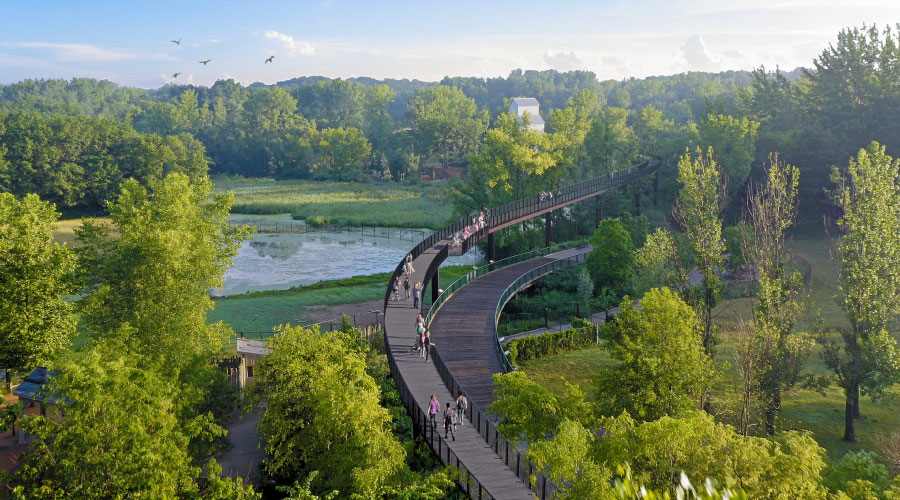
Zoo Transforms Retired Monorail Line into Vibrant Walking Path
Treetop Trail at Minnesota Zoo Offers Visitors a Sustainable Viewing Option. August 17, 2023
By Dave Lubach, Executive Editor
The Minnesota Zoo had an eyesore on its premises and no easy or cost-effective way to remove it.
A monorail that serviced the 500-acre campus and stretched 1.25 miles through the zoo was out of service since 2013. Since then, assets such as the monorail’s cars were sold, and the remaining infrastructure sat there, rusting and unused.
“The track itself and the foundations were very costly to remove,” says Thomas Root, the project management director for the zoo. “So, some sort of complete removal didn’t make a lot of sense.”
Instead of removing the monorail remains, zoo officials opted to reuse the track and convert it into a sustainable raised walkway, the Treetop Trail, to enhance the experience of visitors to the fifth largest zoo in the country.
“The most sustainable building or structure is one that is already there,” says Fraser Reed, structural engineer and associate principal with Buro Happold, the firm that assisted with the design of the trail. “Reimagining something like this, it’s highly sustainable, but this is also an example of how it can be really beautiful and give you this really unique thing because of the history behind it.”
The beginning
The Minnesota Zoo opened in 1978, and the monorail was important for getting visitors around the campus.
“Originally, a lot of the exhibits were featured from the monorail, and it was a desirable angle,” says Root. “But it was about 10 years ago when the monorail just became unserviceable. The parts were obsolete, we were fabricating our own parts. It just became a system that we couldn’t operate anymore.”
The remains of the track, namely the track and infrastructure used to support, was sitting inactive and expensive to remove. There were discussions about recycling the steel, but the effort was not worth the cost to remove it.
Those considerations led to the creation of the Treetop Trail.
“The idea was to generate our mission, which is to connect people, animals and the natural world to save wildlife,” Root says. "We have about half of this loop in the natural wilderness. It’s kind of a heavy forested area of our campus to really able to showcase nature as it should be. And then we also wanted to give people sort of original views of our exhibits and animals from the original monorail vantage point and the walkway would allow people to move at their own pace. A number of years went by to kind of make it happen."
Shortly after the monorail stopped operating, zoo officials conducted a feasibility study to determine the best options to replace it moving forward. The study led to the idea of a 1.25-mile walking path that would rise above the exhibits below it. In some areas the trail reaches 32 feet off the ground. But lots of questions needed to be answered before proceeding.
“At least three years ago we undertook a full construction design, and a lot of things went into consideration,” Root says. “Like with materials, what’s it going to look like, where is it going to stop? Because the trail is elevated, it has to have access points. Where are our construction limitations and then really figuring out working with both the architects, engineers and construction crew about how we build this with the least disruption possible to our facility?”
The challenges for construction also included considerations for the zoo animals. How disruptive will the process be for them? What precautions are needed to work around visitors?
“Not to mention wildlife, we have endangered animals that live on our property as well,” Root says. “We have endangered bumblebees, butterflies, turtles and some owls that live in our property, and so we wanted to make sure that we weren't tree clearing or clearing brush or prairie area when those animals were particularly susceptible. So, we had a lot of partners to help us with that. That was kind of like the biggest effort.”
Moving forward
Planning for the Treetop Trail started in 2018 and the zoo celebrated a groundbreaking ceremony in 2022. The project cost $39 million in public and private money and opened to the public on July 28.
The completed trail includes 22 bump-out overlooks for visitors to use as observation areas. Some of the other structure materials, courtesy of the zoo, include:
- More than 15,000 composite deck boards, enough to make 165 average residential decks.
- 80,000 decking fasteners.
- Nearly 1,000 tons of new structural steel which reinforces angles, walkway frames, and handrails around the curves in the trail.
- More than 1,800 light fixtures in between the railings, alternating left to right every four feet.
- The trail was built in 20-foot modular sections (400 total). Each was wheeled into place by a custom-made trolley fabricated for this project.
One of the bigger challenges Root’s team faces moving forward is the regular maintenance and safety upkeep of the trail, especially when winter weather returns and brings snow and ice accumulation to the walkway.
“Operationally, I think it's just keeping people where they're supposed to be, and that’s not going onto railings and onto the other access points that we don't want them to be and things like that. But I think from the facility side, you know the maintenance, the power washing, keeping the railings free from bird droppings and things like that.”
To deal with snow and ice, the zoo has purchased snow removal equipment, including blowers and leaf blowers, to remove snow and keep the trail open as much as possible during inclement weather. Weight restrictions do not allow for vehicles like pickup trucks on the trail, so the grounds teams will need to use smaller vehicles and equipment to keep the trail safe and clean.
The Treetop Trail provided designers with unique challenges to complete, such as how to work around the animals, how to reinforce aging infrastructure and make it safe for visitors. As one of the engineers who helped with the design, Reed says the trail is an example of what institutional and commercial facilities across the country need to do to make their grounds more sustainable.
“I wish all of our clients were as engaged in reusing what’s there already,” he says. “There’s a world of positive environmental and social benefits that come out of that kind of action.”
Dave Lubach is the executive editor for the facilities market. He has more than eight years of experience covering facilities management and maintenance issues.
Next
Read next on FacilitiesNet












